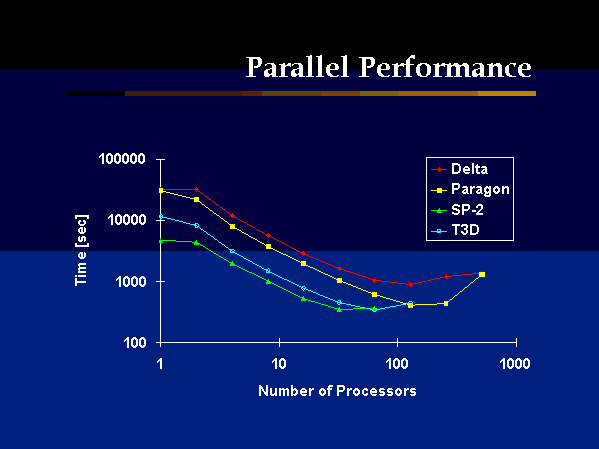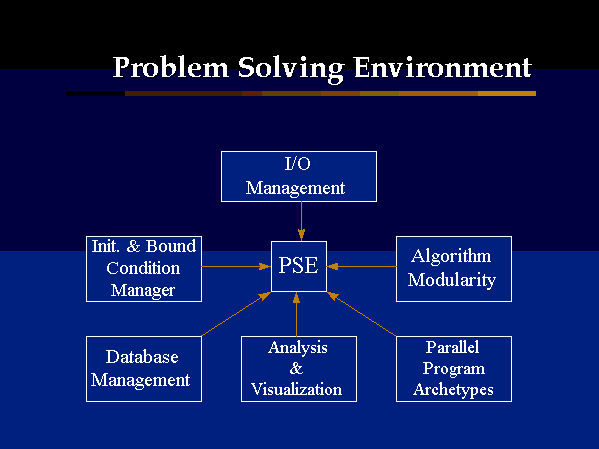
Spring/Summer 1999
Volume 6, Issue 2
Spring/Summer 1998
Volume
3, Issue 1
January 1995
Volume
2, Issue 4
October 1994
Volume
2, Issue 1
January 1994
|
Problem Solving Environments Help Science Come Alive in the Classroom |
|
|
| |
| The primary mission of the CRPC is to make parallel computation truly
usable, with the additional goal of preparing future generations for
scientific problem-solving. CRPC researcher and Computer Science Professor
K. Mani Chandy of Caltech is collaborating with Mechanical and Aerospace
Engineering Professor Donald Dabdub and others at the University of
California at Irvine in the area of Problem Solving Environments (PSEs) to
make parallel computers easier to use. Led by Dabdub, the project is
enabling teachers and students to understand and appreciate the relevance
of science in their daily lives, while taking advantage of parallel
computation.
A PSE is an integrated collection of software tools that is tailored to a specific application area. PSEs enable users to explore scientific or engineering problems in areas as diverse as plasma physics, cosmology, and airshed modeling. Internet-based collaboration technologies help distributed groups of people use shared PSEs to solve problems together. Because of this, PSEs are ideal teaching tools as well as facilitators for collaborative research. They make possible the ultimate in usability-the ability to deal with complex scientific problems without having to be concerned about parallelism at all. PSEs can support collaborations between people with different interests in solving a common problem. For example, chemists, environmental engineers, health professionals, business leaders, and public policy experts may collaborate on making decisions about an emission-control strategy in Los Angeles County. These people may use different tools corresponding to their specific interests. All these tools have to be linked into a collaborative PSE. The PSE for airshed modeling enables teachers, students, and concerned citizens to use parallel computing to study air pollution patterns and understand the consequences of public policy on pollution control. The PSE deals with the South Coast Air Basin of California, but is being extended to other regions, and to models at a continental and worldwide scale. This PSE project has different goals for K-12 and college students. The primary goal for schoolchildren is to show them the importance of science in their daily lives in an immediate and direct way. Science comes alive with tools that help students drive scenarios where they can understand the impact of temperature, wind patterns, automobiles, electric vehicles, biomass, and factories on the air that they breathe. The PSEs guide students as they explore a variety of scenarios. Schoolchildren will use commodity uniprocessor machines, including easily installed single processor Windows machines, whereas college students are more likely to have access to parallel supercomputers. The PSE for schoolchildren will use pre-calculated scenarios tailored to their needs. The datasets of the Southern California airshed require several megabytes, and because schools have lower-bandwidth access to the Internet than colleges, the researchers plan to put the PSE on CD-ROMs for K-12 use. The K-12 phase of the project is now being launched in collaboration with Visiting Associate Thomas Sterling of the Center for Advanced Computing Research at Caltech. The goal for college students is to introduce them to computational modeling of the environment. Because college students can use parallel computers, the backend of the PSE can execute on a variety of parallel machines. "The front end is where all visualization and pictures take place, and the back end is where number-crunching and computing occurs," explains Dabdub. "The PSE allows the front end to be run on a Windows personal computer, while the heavy-duty computations are being performed in a massively parallel machine." The PSE has been used to teach students at the University of California at Irvine and at Lyon College, a liberal arts school in Arkansas, and is being explored for use by other colleges. Results of a student evaluation showed that on average, 80% of the features of the PSE were useful to gain a greater understanding of the dynamics of atmospheric pollutants. The single feature considered most instructive by the students was the ability to generate animated color contour plots of pollutant mixing ratios. For more information on the airshed modeling project, see http://albeniz.eng.uci.edu/PSE. For more information on the PSE project, see http://www.extreme.indiana.edu/pseware/index.html . |
 Figure 1 CPU time for a 24-hour simulation of the South Coast Air Basin using a parallel version of the Caltech model on various parallel architectures.
|
